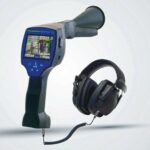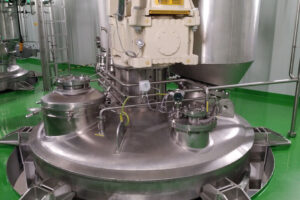Typical applications of compressed air in the food industry are processes such as cleaning, filling, mixing, spraying, cutting, transporting and packaging. According to experts, 80 % of the costs incurred in this way are attributable to energy use. It is therefore essential to avoid leaks in compressed air lines. Typically, compressed air escapes through unintentionally open valves, leaking pipe connections, couplings and seals. How much compressed air is lost depends on the system pressure, the size of the leak, and the annual operating costs. A leakage of only 1 mm diameter, for example, causes 12.3 l of compressed air loss per minute at a pressure of 6 bar.
Telltale ultrasound sounds
Beko Technologies helps companies find individual solutions for their compressed air treatment and ensure compliance with the required quality and energy efficiency in the process. To prevent costly compressed air losses, the manufacturer offers the Metpoint CID device. The leakage management system reliably finds leaks in the lines. Before use, data such as system pressure, compressed air costs and annual operating hours are entered in the configuration menu. Subsequently, compressed air loss and savings potential can be calculated on a company-specific basis.
Metpoint CID enables rapid leak detection during operation and even in hard-to-reach areas. Typically, the battery-powered handheld unit with a runtime of up to nine hours is used at a distance of 0.2 m to 6 m. A sonic funnel detects and focuses the ultrasonic sounds generated by escaping air, which are inaudible to the human ear. Once a leak is found, its position and size are visually displayed by the integrated camera on the color touch display. Those who do not want to constantly look at the screen during leak detection can also perceive leaks acoustically via headphones. Disturbing ambient noise is masked out. In addition, a laser distance measurement determines the intensity of the leakage in decibels and automatically quantifies the loss of compressed air as well as the resulting costs already during the operation. A screenshot is taken to store the data. Leak tags mark the leaks with information such as the name of the defective element, the priority of the repair and the name of the inspector.
Software for data management
Metpoint CID‘s integrated software provides clear sorting and filing of the acquired measurement data after transfer to a PC. The information can then be assigned to different buildings and projects and sorted and filtered as desired. The priority and status of the leakage can also be noted. Automated reports are created with just a few clicks. Finally, a report is generated in accordance with DIN 50001, which contains all master data and detailed information as optimal preparation for the elimination of the leakage.
Flexible use
The Metpoint CID leakage management system can also be equipped with a directional tube, which is used in the case of compressed air lines that are spatially close together and in the direct vicinity of leaks. Compared to the usually used bell, the tube with its small opening at the tip allows the smallest leaks to be located with pinpoint accuracy. For use from great distances of 3 to 15 m, on the other hand, a parabolic mirror is placed on top. This can precisely detect the ultrasonic waves emanating from a leakage by means of an integrated targeting laser and an ultrasonic microphone.
Beko Technologies GmbH, Neuss











